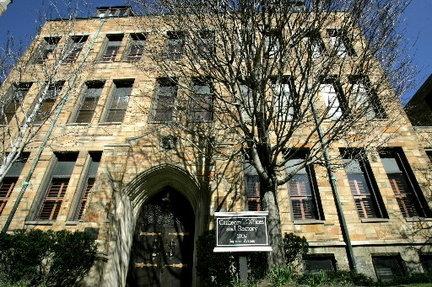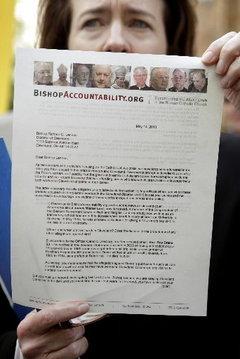By Michael O'Malley
Plain Dealer
June 7, 2010
http://blog.cleveland.com/metro/2010/06/catholic_church_faces_renewed.html
CLEVELAND, Ohio - With the Roman Catholic Church thrust into headlines again over allegations of hiding and protecting pedophile priests, the institution faces renewed scrutiny of its vow to be open and honest about clerical sex abuse.
Recent claims of pedophile cover-ups reaching all the way to the Vatican have victims' advocate groups questioning whether the church -- diocese by diocese -- has done all it can to expose predators.
National watchdog groups, which see varying degrees of openness across the country, give the Cleveland diocese low marks.
 |
| Bishop Richard Lennon lives with other priests at the St. John Cathedral Rectory behind the church, above the archway door on Superior Ave. in downtown Cleveland |
After the scandal broke in Boston eight years ago, the U.S. Conference of Catholic Bishops adopted measures to ensure that dioceses would have procedures in place for addressing allegations of sexual abuse involving children.
But since the church is a private institution, there is limited public access to its documents or personnel files. Unless a case is brought into a court of law, the public must rely on the church to police itself and release information, including the names of pedophile priests.
The archdiocese of Baltimore was the first in the country to release names of accused priests.
"It was the right thing to do," said archdiocese spokesman Sean Caine, crediting now-retired Cardinal William Keeler for making the decision as the abuse scandal gained momentum in 2002. "He recognized that something significant was needed to rebuild the trust between the church and the Catholic community. He saw it as a way of shining a light on a dark place."
Conference
Guidelines:
These are the measures outlined by the U.S. Conference of Catholic Bishops eight years ago in response to the abuse scandal:
When a diocese receives an accusation about a priest, it immediately reports the alleged incident to police or a prosecutor.
Then a diocesan review board -- made up of lay people and clergy -- examines the charge. If the allegation is determined to be "credible," the accused cleric is place on leave.
When an accused priest is placed on leave, he can't celebrate the sacraments or wear a Roman collar. He waits in a state of limbo while either a Vatican panel in Rome or his local bishop continues the inquiry.
Depending on the finding, the priest could be defrocked, sentenced to a life of penance in a place away from children or reinstated to the ministry.
Guidelines:
These are the measures outlined by the U.S. Conference of Catholic Bishops eight years ago in response to the abuse scandal:
When a diocese receives an accusation about a priest, it immediately reports the alleged incident to police or a prosecutor.
Then a diocesan review board -- made up of lay people and clergy -- examines the charge. If the allegation is determined to be "credible," the accused cleric is place on leave.
When an accused priest is placed on leave, he can't celebrate the sacraments or wear a Roman collar. He waits in a state of limbo while either a Vatican panel in Rome or his local bishop continues the inquiry.
Depending on the finding, the priest could be defrocked, sentenced to a life of penance in a place away from children or reinstated to the ministry.
But critics say dioceses began releasing the names only because of public pressure.
"Releasing those names was not pro-active on their part," said the Rev. Tom Doyle, a Dominican priest from Virginia who is a canon lawyer and who counsels victims of clergy abuse. "If not for Boston, they would have done nothing, just like they've been doing nothing for centuries."
Naming names
According to victims' advocates, releasing names to the public is vital for protecting children, healing victims and helping other victims come forward, knowing they are not alone.
The Philadelphia archdiocese -- regarded by reformers as a national model for disclosing information on abusive priests -- prominently displays pictures of more than 60 clerical predators, dead and alive, on its website, along with biographical information and detailed information about where they served.
The Toledo diocese, said to be the most open in Ohio, displays on its website the names of 21 clerics dating back to 1950.
In the Cleveland diocese, five priests -- one on leave, three removed from the clerical state and one who resigned -- are currently named on its website in postings from 2007, 2008 and 2009.
Spokesman Robert Tayek said that beginning in 2002, and continuing for seven years, the diocese had a separate notice posted with the names of 10 accused priests put on leave. He said that notice also listed the names of 12 other priests no longer in active ministry because of past allegations that they abused minors.
The diocese said only one accused priest -- who is named on the current website -- has been placed on leave since 2004 while his case is reviewed. And, according to the diocese, there are no cases pending before its review board, which examines allegations lodged against priests and makes recommendations to the bishop.
A number of dioceses, including Cleveland, say they publicly disclose the names of priests against whom credible accusations are lodged, even if they have not been criminally or civilly charged. Those disclosures go beyond what the bishops conference recommended in 2002.
"Getting those names out strengthens and enables victims to come forward because they realize the initial burden of evidence is not on them," said Richard Tollner, 51, of upstate New York, who said he was repeatedly abused by a priest when he was a teenager.
Tollner, who remains angry that a Vatican panel cleared the priest, first spoke of the abuse publicly in 2002. His widely reported story prompted two more victims to come forward, he said.
"It takes time for people to come forward because of the trauma," said Tollner.
Cleveland cases sealed by Judge Brian Corrigan
Many of Cleveland's clerical sex-abuse cases were sealed by Cuyahoga County Common Pleas Judge Brian Corrigan following a seven-month grand jury investigation in 2002. The diocese, which pushed the court to seal the files, will not release those names.
In 2004, then-Bishop Anthony Pilla said -- without naming names -- that there had been sex abuse claims against 118 of the diocese's clergymen since 1950.
The Boston-based church reform group BishopAccountability.org, citing newspaper stories, court records and police reports, has identified 45 on its website and challenged the Cleveland diocese last month to disclose the identities of the other 73.
In an e-mail to The Plain Dealer, Tayek, the diocese's spokesman, said: "Many of the allegations are unsubstantiated, frivolous or involve individuals no longer associated with the diocese. Releasing all of the names would serve no constructive purpose."
He also reiterated that, like most dioceses, Cleveland will not name priests accused of abuse after their deaths.
"In the case of a deceased priest, there is no means to assess credibility, no means to unequivocally establish the truth, and since there is no risk to the community, the name is not published. However, the Diocese is open to hearing from any individual and if warranted, assisting them," Tayek wrote.
The Cincinnati archdiocese and the Columbus diocese also do not name priests accused after their deaths.
But Cincinnati does post an annual tally on its website of accusations against priests, along with the outcomes of the cases and how much money it spends on counseling and child protection programs.
"People are angry that the abuse has occurred," said Dan Andriacco, spokesman for the Cincinnati archdiocese. "We're angry too. But once it occurred, we had to do something about it."
Currently, Cincinnati's web site names five priests on leave after the archdiocese's review board found allegations against them were credible.
Columbus prints names in diocese newspaper
The Columbus diocese publishes names of priests in its diocese newspaper when there are credible allegations.
According to Deacon Thomas Berg, 28 priests have been accused over the last 60 years. Over the last 10 years, the diocese has found credible accusations against five priests, all of whom have either been removed from the priesthood or are in the process of removal.
Since the national scandal erupted eight years ago, Ohio dioceses and those across the country have put programs in place to guard against more abuses and to assist victims.
For instance, Cleveland continuously does background checks on clergy and employees who have contact with children, said the Rev. Lawrence Jurcak, the diocese's secretary and vicar for clergy. He said the diocese also has established standards of conduct for ministers dealing with children and educates young people about sexual abuse.
In addition, Cleveland and other dioceses say they notify parishioners when a credible claim is lodged against a priest.
But skeptics question whether the identities of some sexually abusive priests remain cloaked.
ann-barrett-doyle-letter-to-bishop-051410.jpgView full sizeLonnie Timmons III, The Plain DealerAnn Barrett Doyle, co-director of the Boston-based BishopAccountability.org, holds a letter to the Bishop Lennon that requests that the Cleveland Catholic Diocese release the names of priests accused of sexually molesting minors during a protest on Friday, May 14, 2010 in front of St. John's Cathedral in Cleveland. Anne Barrett Doyle, co-director of BishopAccountability.org, believes Cleveland is withholding names.
She bases her claim on the low number of names revealed by the local diocese, compared to others, and on calls she said she has received from people who claimed they were abused by Cleveland clerics.
Doyle, who is no relation to the Dominican priest quoted above, specifically questioned the diocese's statement that only one priest has been put on leave since 2004.
"That's just ludicrous," she said. "Either they're lying or they're applying a standard of credibility that is irresponsible."
Doyle points to Manchester, N.H., where the attorney general's office in 2002 launched a criminal investigation of the Catholic diocese, which, at the time, was not releasing names of sexually abusive priests.
List grew to over 60
During the investigation, the diocese began releasing some names and with BishopAccountability.org pushing the issue, the list grew to more than 60.
Senior attorney general Will Delker said his office was preparing to criminally prosecute the diocese if it did not release names in records sealed as part of a grand jury investigation.
"We were going to charge them with endangering the welfare of a child," he said.
Last year, the attorney general's office publicly named 27 additional abusers, including deceased priests.
 |
| Ann Barrett Doyle, co-director of the Boston-based BishopAccountability.org, holds a letter to the Bishop Lennon that requests that the Cleveland Catholic Diocese release the names of priests accused of sexually molesting minors during a protest on Friday, May 14, 2010 in front of St. John\'s Cathedral in Cleveland. |
New Hampshire Associate Attorney General Kristin Spath said in a telephone interview that her office released the names of the dead "because of our right-to-know law in this state."
The Philadelphia archdiocese, now considered the model for openness, reported in 2002 that over the last 50 years it had received 35 credible allegations of sexual abuse by priests, prompting the district attorney's office to wonder why it only knew of one case.
The office launched an investigation and in 2005 announced that it found 171 accusations, 63 of which it determined were credible and released the names.
"Over the decades every diocese, I believe, based on my experience, followed the same procedure in covering up the harming of children in the United States by Catholic priests," said Charles Gallagher, a former Philadelphia deputy district attorney who led the investigation.
"Without a criminal investigation, all the information we get from them is based on self-reporting. And I still question whether or not they're being completely truthful to the public today."
Any original material on these pages is copyright © BishopAccountability.org 2004. Reproduce freely with attribution.